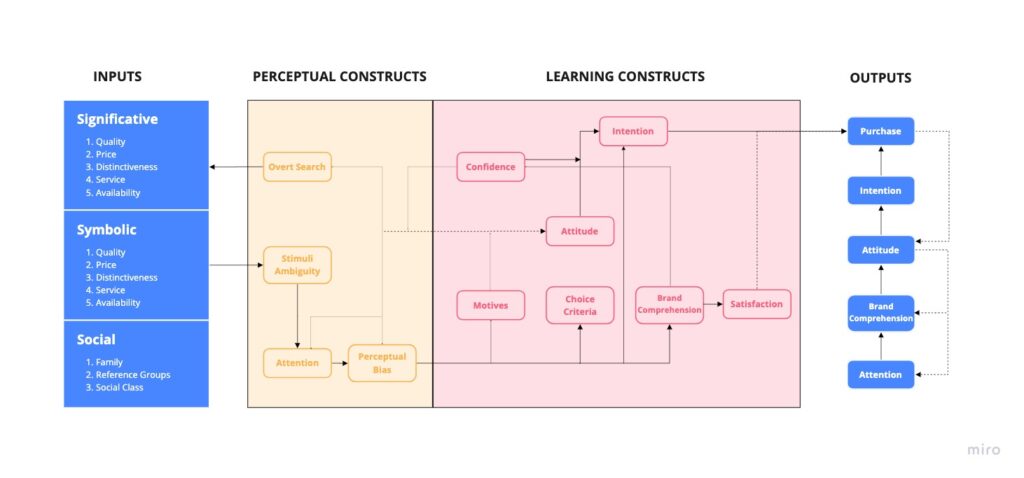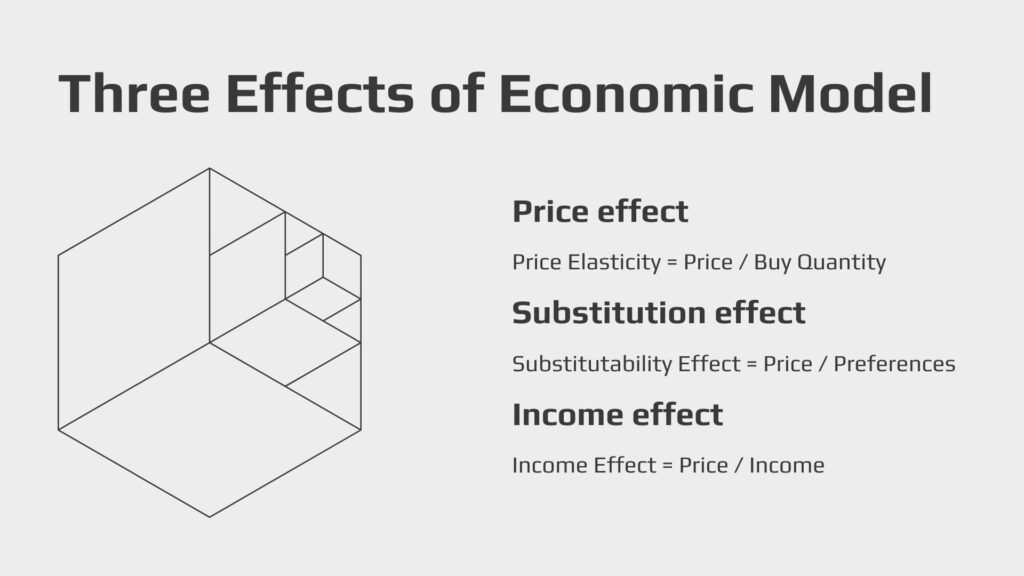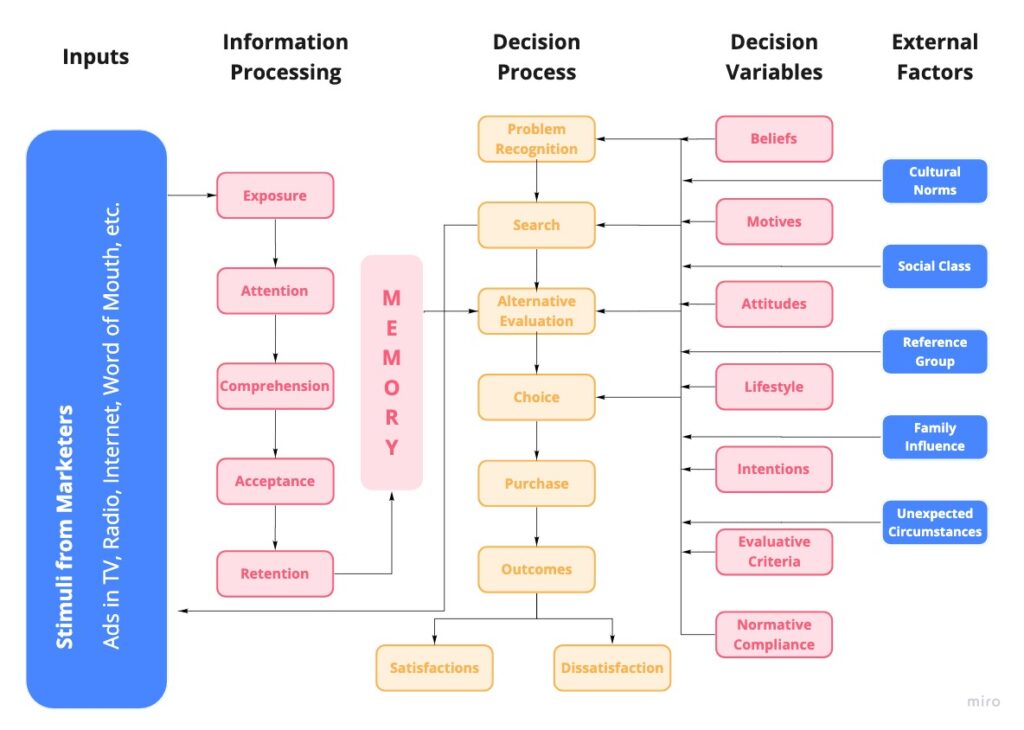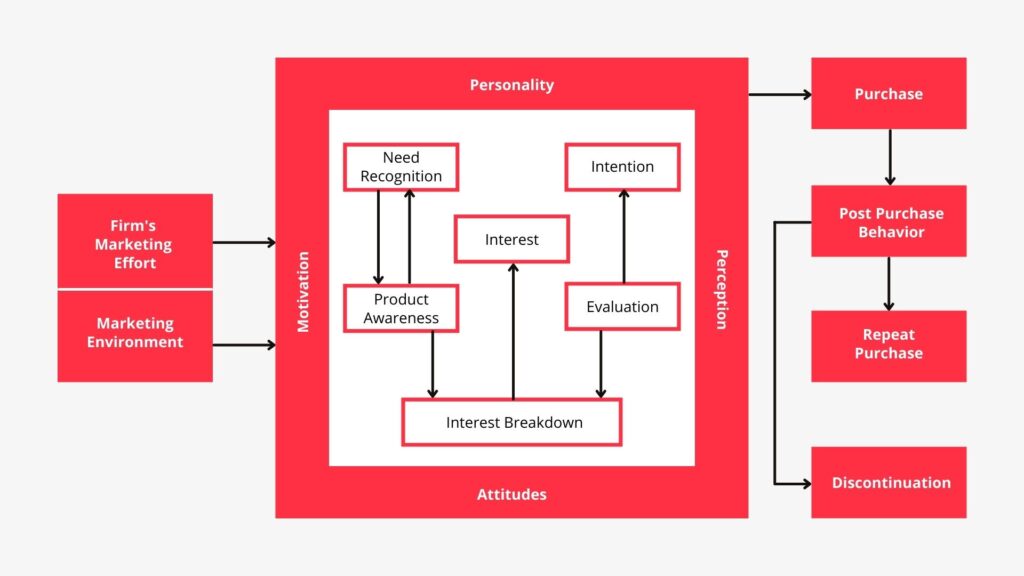What is a Consumer Behavior Model?
A consumer behavior model is a theoretical framework that is used to understand the relationship between people and their environment. The models can be divided into two types:
- Normative Models– These are usually designed for social scientists and behavioral economists, who use them to explain how people behave in certain situations or environments.
- Structural Models– These are designed for marketers and business students, who use them to describe the various ways in which consumers react to marketing stimuli such as product features, pricing, or advertising messages.
7 Types of Consumer Behavior Models
Nicosia Model
Nicosia model shows the relationship between attributes of customers, consumer decision-making process, and marketing communications of an organization, as well as, the feedback from the customer to the organization. It particularly deals with the formulation of customer needs, standards of the comfort zone, and potential willingness to pay. The attributes include personality, demographics (age, sex, etc.), social influences in which consumers live in different parts of a city or country, etc.
The model also shows how customers perceive value from a product or service, make their price comparison between different products or services, use various inputs to assess the value of a product, etc. Marketing communications are represented as advertisements in newspapers and television channels. The feedback is obtained from customer surveys, focus group meetings, etc which tell about whether there were differences among customers according to different communications elements.
Read our comprehensive blog on Nicosia Model here >>

Howard Sheth Model
In 1969, John Howard and Jagadish Sheth published a book called ‘The Theory Of Buyer Behavior’ which describes how people make buy decisions when they shop for products. The Howard Sheth model of consumer behavior is a sophisticated integration of social, psychological, and marketing influences on consumers’ choices into one coherent sequence. The idea is to make a model of human behavior and how it works in the brain. We want to know what makes people behave like they do when they buy certain things.
The Howard model represents a comprehensive view of human behavior as seen from the perspective of social influence. The model reveals that while social influences can overpower psychological and marketing factors, the power of information technology should not be underestimated either. In other words, convergence is taking place whereby consumers are increasingly status-driven as well as individualistic in their choice behaviors. It builds on these aspects and other insights from psychology, price signaling, choice modeling theory (Janschewitz & Soltau 1997), decision-making research in organizations (Whitley 1982), Kahneman’s framework (Kahneman & Tversky 1974/1979), economic theory, physiology—hence the brain.
Read our comprehensive blog on Howard Sheth Model >>

Economic Model
The foundational belief of the economic model of consumer behavior is that human beings are rational. Although this belief has been disapproved in recent developments, this model holds good in certain situations. Under this view, people consider the following questions:– What is in it for me? How much will I have to pay and can I afford to buy it in exchange for what performance and quality? Can a purchase be deferred because of future expectations like owning a dress in order to wear on special occasions? This question is often answered by the basic premise of long-term commitment.
According to this model, consumer behavior is driven by the principle of maximum utility based on the law of diminishing marginal utility. The law of diminishing marginal utility says that the marginal utility from each additional unit declines as consumption increases. Thus, the decision to buy a product depends on two elements: 1. Purchase price 2. The extent of consumption at this particular point in time.
Read our comprehensive blog on Economic Model of Consumer Behavior >>

Engel Kollat Blackwell Model
The Engel Kollat Blackwell Model is a consumer behavior model of the cognitive process that helps to predict what customers are going to buy. The model consists of three different categories, namely: Present Situation – this is where the customer is at the current moment, Desired State – this is where the customer wants to be in the future and it will help them achieve their goals, and Pathway for Movement from one state to another – this includes various steps that may include various products or services which can help move towards their desired state.
EKB model was created in 1968. Later this model went through several revisions, updates, and improvements to become the Engel, Blackwell, and Miniard Model (EBM) in the 1990s.
Read our comprehensive blog on Engel Kollat Blackwell Model >>

Sociological Model
The Sociological model of consumer behavior is a framework that seeks to explain why people behave as they do, and comprises three interacting components: the psychological component – how we think about products; the structural component – our perception about their social role in society, and finally the political economy-the impact of economic resources on our decision to purchase or walk away.
According to the model, a consumer is a part of the society and he may be a member of many groups in a society. His buying behavior is influenced by these groups. It may be surprising to know that man has long existed under many types of social groups, classes, and castes. His responses change accordingly depending on these various forms of relationships. Marketers must recognize this factor of social influence on buying behavior. Social groups may influence consumers’ decision-making by controlling perceived needs, so it is important to know what alternatives are available in their area locally and globally.
Read our comprehensive blog on the sociological model of consumer behavior >>
Pavlovian Learning Model
In the Pavlovian learning model, humans learn from associations between stimuli and their effects. Through the repeated association of a stimulus with some effect (e.g., reward), an automatic response occurs as a conditioned reflex that is designed to promote responses associated with those same positive or negative indications. Unlike the James-Lange theory, which marked reward for certain overt behaviors through an interaction of physiological processes with the conscious will to act. Under this psychoanalytic model of behavior, the gratification was tied only to successful performance in providing pleasure. The Pavlovian theory marks avoidance via relief from punishment through the association of a stimulus with tangible pleasure or tangible pain.
The Pavlovian model was formed from an experiment conducted by the Russian physiologist, Ivan Pavlov between 1904 and 1910. Researchers at that time did not know how to elicit behavioral responses in human subjects, but rather trained dogs to indicate when they received food by pulling a chain attached to their forepaws or tails. As the experiments progressed, Pavlov noticed that subjects react more frequently with increased stimuli which are associated with previous rewards. He also observed how he could predict his dog’s actions after he had fed them for fifteen consecutive sessions.
As the classical conditioning experiments continued, after extended training of between sixty-five to ninety-three trials, Pavlov encountered a suggestion that his dog’s reactions could be triggered through association. He then conducted tests with other animals where he timed how quickly they would react after a sound was played, and found they would respond more quickly if the same signal arrived on successive trials.
Once Pavlov had established that his conditioned reactions could be triggered through association with rewards he continued to observe how those responses were now linked from one stimulus-related response to another in the form of behavior. He subsequently conducted tests in response to his animal subjects that demonstrated that when he made a favorable sound or presentation before them they would respond more vigorously than if no stimulus was delivered. This then prompted him to investigate how this interconnection between stimuli could be established improved based on the pairing of rewards.
He conducted his study again with a dog to see if it was possible for them to associate two stimuli when one occurred after another. In these experiments, he placed the subject in an enclosure and set up a sound that would occur whenever food or water became available. After a period of time and after several pairings his dog could associate the stimulus with having food or water. This was eventually accepted as Pavlovian conditioning because it demonstrated how the association between stimuli mediated reactions.
Read our comprehensive blog on the Pavlovian model of consumer behavior >>

Black Box Model
The model (or framework) of consumer behavior was first devised by Professor Geoffrey Jones and his colleague at the Center for Marketing Studies, Cambridge University. It has been elaborated on further by Australian academics such as Rodney Hitchin. They suggested that often consumers are not sure about what influences their buying decision process. The answers to those questions are often buried within the customer’s mind. The model consists of three major components namely: Environment, Buyer’s black box, and Buyer’s responses.
Read our comprehensive blog on the black-box model of consumer behavior >>

FAQs on Consumer Behavior Models
What is the model of a man in consumer behavior?
The model of a man in consumer behavior is based on two aspects: Masculinity and Risk. Masculinity includes values such as courage, strength, domination, control over women, physical aggression. These are all traits that are commonly seen in men today. Men are also seen as being more risk-takers than women with their perceived willingness to try new things or take risks that may have severe consequences for themselves. Risk has been defined by models of man as “the probability of an adverse outcome multiplied by its potential severity.” This definition of risk is different from other definitions because it doesn’t include negative outcomes like bankruptcy or divorce; instead, it only includes positive outcomes like success or happiness.
What are the 4 types of consumer buying behavior?
1) Complex buying behavior 2) Dissonance-reducing buying behavior 3) Habitual buying behavior 4) Variety seeking buying behavior
What are the 3 types of buying situations?
Buying products on the fly: This is when you are shopping for something and not interested in any long-term commitments or other obligations like making monthly payments or signing up for services. Buying for immediate gratification: This is when you need to buy something now, but don’t want to commit to anything long-term like paying for a subscription service or purchasing an item at full price. Buying for the future: This is when you are planning ahead and know that you will need something later on down the road, so this purchase would be considered an investment.
